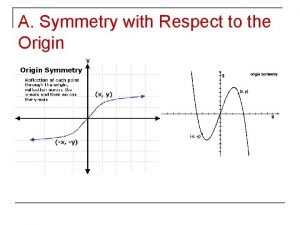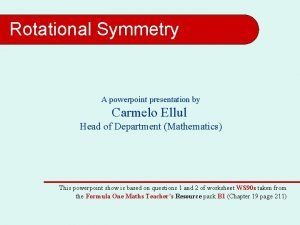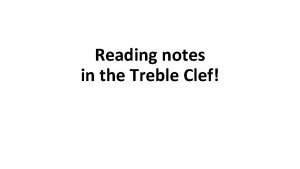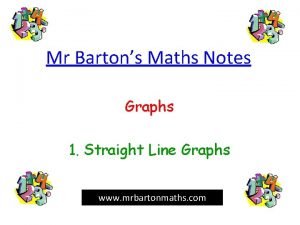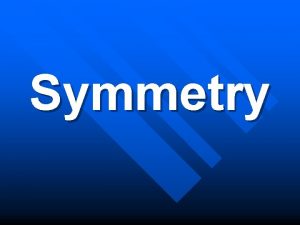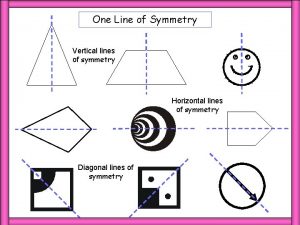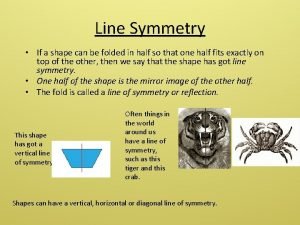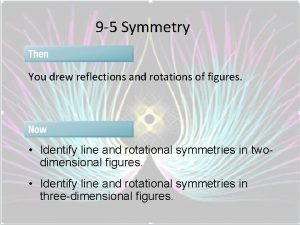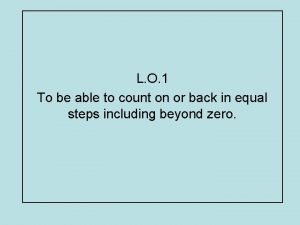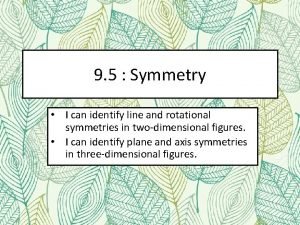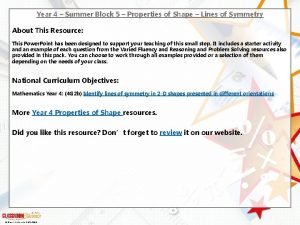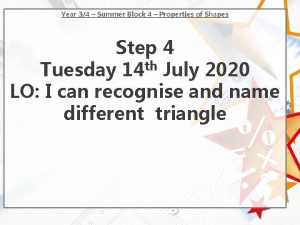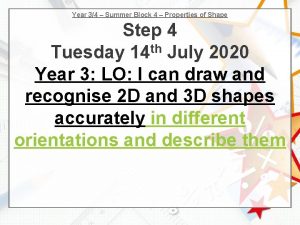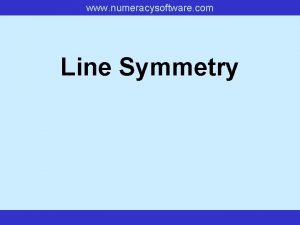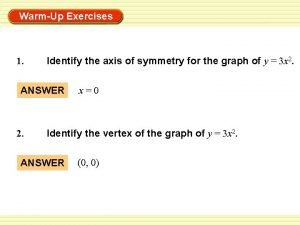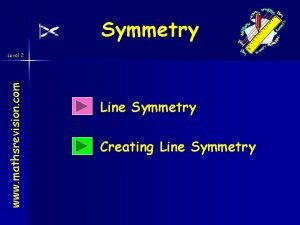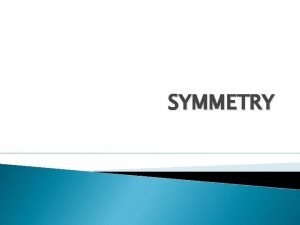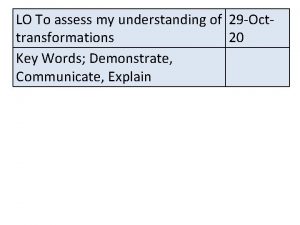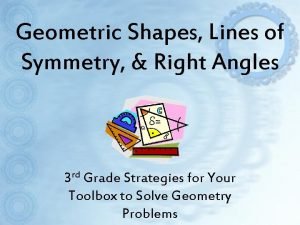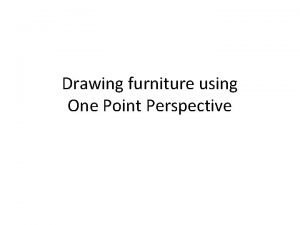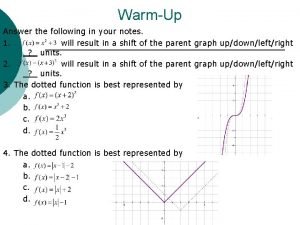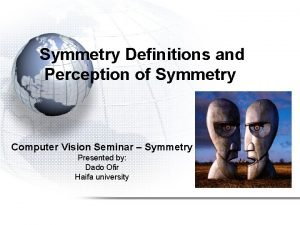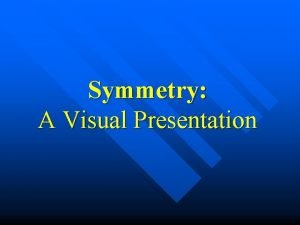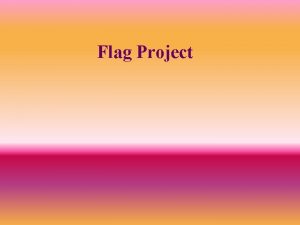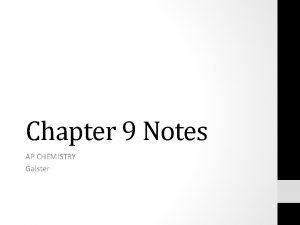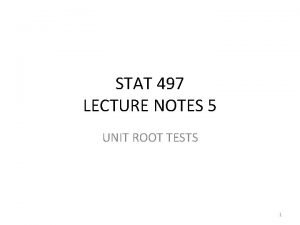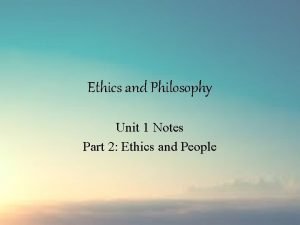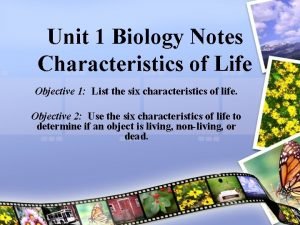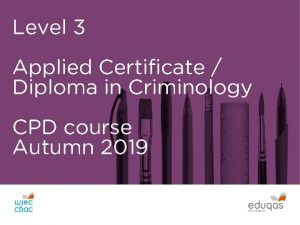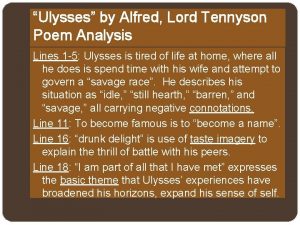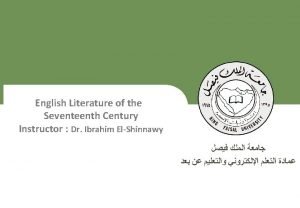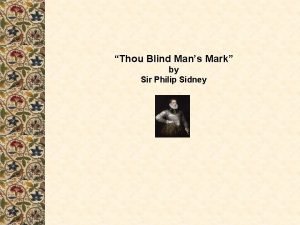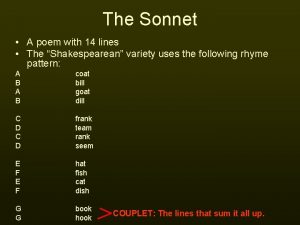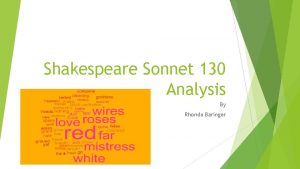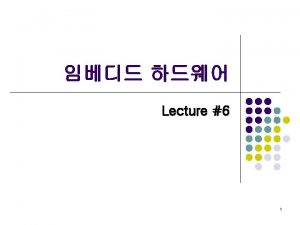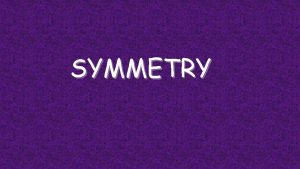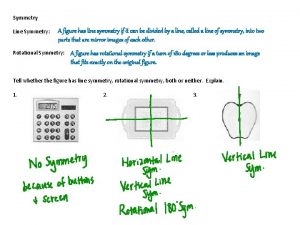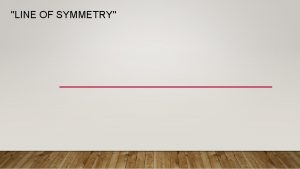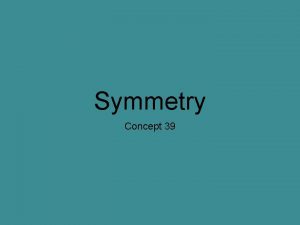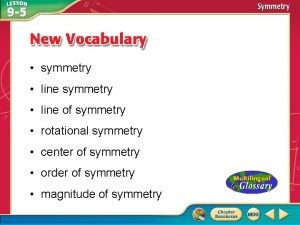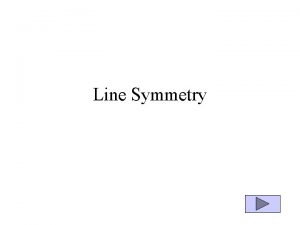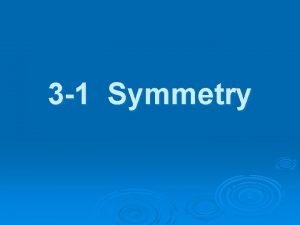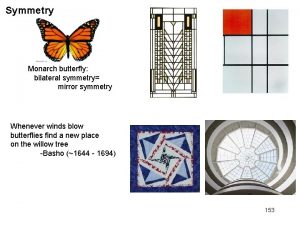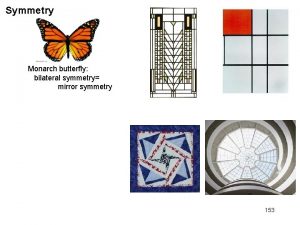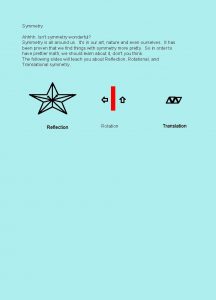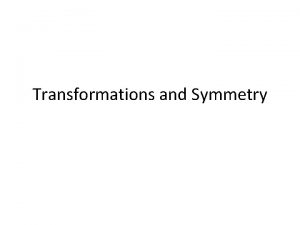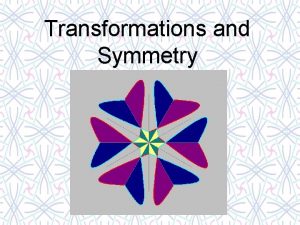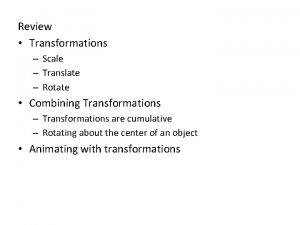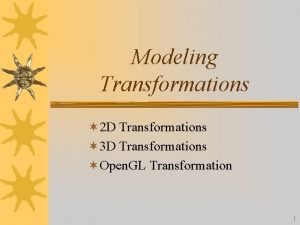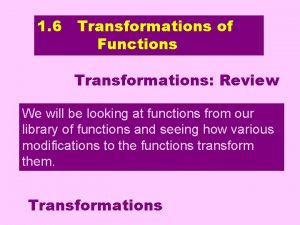Unit 13 Transformations Notes on Symmetry Line Symmetry




















































- Slides: 52

Unit 13 Transformations

Notes on Symmetry

Line Symmetry A figure in the plane has line symmetry if the figure can be mapped onto itself by a reflection in a line. The line of reflection is a line of symmetry.

Lines of Symmetry How many lines of symmetry does the hexagon have?

Lines of Symmetry How many lines of symmetry does the hexagon have?

Rotational Symmetry A figure in a plane has rotational symmetry if the figure can be mapped onto itself by a rotation of 180 o or less about the center of the figure. This point is the center of symmetry. Note that the rotation can be either clockwise or counterclockwise.

Rotational Symmetry The figure below has rotational symmetry.

Rotational Symmetry Does the figure have rotational symmetry?

Rotational Symmetry Do the following figures have rotational symmetry?

Reflection Notes

Transformation A transformation moves or changes a figure in some way to produce a new figure called an image.

Isometry An isometry is a transformation that creates a congruent image. Types of isometries Translations Reflections Rotations

Another name for the original figure is the preimage. Another name for the new figure is the image.

Notation Every point in the original figure, preimage, is denoted with a capital letter (Ex: P, Q, R), while every point in the image is denoted with a capital letter followed by an apostrophe (Ex: P’, Q’, R’)

Reflection A transformation that uses a line like a mirror to reflect a figure. The mirror line is called the line of reflection.

Line of Reflection

Coordinate Rule for Reflections If (a, b) is reflected over the y-axis, its image is the point (-a, b) If (a, b) is reflected over the x-axis, its image is the point (a, -b)

Coordinate Rule for Reflections If (a, b) is reflected over the line y = x, its image is the point (b, a) If (a, b) is reflected over the line y = -x, its image is the point (-b, -a)

Coordinate Rule for Reflections If the point (4, 7) was reflected over the line y = x, what would be its image? If the point (2, -5) was reflected over the xaxis, what would be its image? If the point (-3, 6) was reflected over the y -axis, what would be its image? If the point (-8, -3) was reflected over the line y = -x, what would be its image?

Examples

Rotations

Rotations A rotation is a transformation in which a figure is turned about a fixed point called the center of rotation. Rays drawn from the center of rotation to a point and its image form the angle of rotation.

Coordinate Rules for Rotations about the Origin When a point (a, b) is rotated counterclockwise about the origin: For a rotation of 90 o, (a, b)→(-b, a) For a rotation of 180 o, (a, b)→(-a, -b) For a rotation of 270 o, (a, b)→(b, -a)

Coordinate Rules for Rotations about the Origin Remember… 90 o counterclockwise = 270 o clockwise 180 o is the same from either direction 270 o counterclockwise = 90 o clockwise If counterclockwise/clockwise is not stated, assume it is counterclockwise.

Rotations Trapezoid has vertices E(-3, 2), F(-3, 4), G(1, 4) and H(2, 2). Find the vertices of the image for a 180 o rotation about the origin.

Rotations Trapezoid has vertices E(-3, 2), F(-3, 4), G(1, 4) and H(2, 2). Find the vertices of the image for a 90 o rotation clockwise about the origin.

Rotations Quadrilateral RSTU has vertices R(3, 1), S(5, 1), T(5, -3), and U(2, -1). What are the coordinates of the vertices after a rotation of 270 o counterclockwise about the origin.

Rotations Triangle EFG has vertices E(-3, 2), F(-4, 4), and G(1, 3). What are the coordinates of the vertices after a rotation of 90 o counterclockwise about the origin.

Dilations

Dilation A dilation is a transformation that stretches or shrinks a figure to create a similar figure. A dilation is not an isometry.

Scale Factor of Dilation The scale factor of a dilation is the ratio of a side length of the image to the corresponding side length of the original figure.

Reduction A reduction is any dilation where the image is smaller than the original figure. The scale factor of a reduction is less than 1. For example, If P(6, -4) and we use a scale factor of ½, P’(3, -2).

Enlargement An enlargement is any dilation where the image is larger than the original figure. The scale factor of an enlargement is more than 1. For example, If G(-3, 2) and we use a scale factor of 3, G’(-9, 6).

Find the scale factor of the dilation. Then tell whether the dilation is a reduction or enlargement.

Coordinate rules for Dilations If the scale factor is n, then (x, y) changes to (nx, ny)

Examples: Using a scale factor of 3, (5, -3), changes to ? (15, -9) Using a scale factor of 2/3, (-6, 12) changes to? (-4, 8)

Graph the triangle with points A (1, 2), B(3, -4) and C (-2, 3). Then dilate the triangle with a scale factor of 2.

Graph the triangle with points A (1, 2), B(3, -4) and C (-2, 3). Then dilate the triangle with a scale factor of 1/2.

Use a dilation of 3/2 to find the image.

Translation A translation moves every point of a figure the same distance in the same direction. (Think of sliding the figure right, left, up or down) Coordinate notation is denoted by (x, y)→(x + a, y + b) where a and b are numbers. Vector form is denoted by <a, b> where a and b are horizontal and vertical movement.

Translations Quad ABCD has vertices A(-1, 2), B(-1, 5), C(4, 6), and D(4, 2). Find the image of each vertex after the translation (x, y)→(x + 3, y – 1).

Vectors

Translate the following The vertices of triangle LMN are L(2, 2), M(5, 3), and N(9, 1). Translate the vertices by: (x, y)→(x – 5, y + 3)

Composition of Transformations

Composition of Transformations When two or more transformations are combined, the result is a composition of transformations. Simply execute both transformations in order.

Composition of Transformations The endpoints of RS are R(1, -3) and S(2, -6). Graph the image of RS after the composition. Reflection in the y-axis Rotation 90 o about the origin

Glide Reflection A glide reflection is composition of a translation and a reflection. A translation maps P to P’ A reflection in a line k parallel to the direction of the translation maps P’ to P’’

Glide Reflection The vertices of Triangle ABC are A(3, 2), B(6, 3) and C(7, 1). Find the image of Triangle ABC after the glide reflection (x, y)→(x – 12, y) Reflection in the x-axis

Reflection in Parallel Lines Theorem If lines k and m are parallel, then a reflection in line k followed by a reflection in line m is the same as a translation.

Example Reflect across the y-axis and the line x = 4. Q(-1, 2) and P(-2, 7). What is the distance between P and P”?

Reflection in Intersecting Lines Theorem If lines k and m intersect at point P, then a reflection in k followed by a reflection in m is the same as a rotation about point P. The angle of rotation is 2 xo, where xo is the measure of the acute or right angle formed by k and m.

Example Reflect across the x-axis and the line y = -x. Q(-2, -1) and P(-6, -2). What is the angle of rotation between P and P”?
 2110004
2110004 Unit 6 review questions
Unit 6 review questions Cube wisc
Cube wisc What does origin symmetry look like
What does origin symmetry look like Order of rotational symmetry
Order of rotational symmetry Every good boy does fine for the notes on a scale
Every good boy does fine for the notes on a scale Mr barton maths
Mr barton maths How many planes of symmetry does a hexagon have
How many planes of symmetry does a hexagon have How many lines of symmetry in a pentagon
How many lines of symmetry in a pentagon How many planes of symmetry does a hemisphere have
How many planes of symmetry does a hemisphere have One line
One line Whats a line of symmetry
Whats a line of symmetry State whether the figure appears to have line symmetry
State whether the figure appears to have line symmetry What shape has 6 sides
What shape has 6 sides State whether the figure appears to have line symmetry
State whether the figure appears to have line symmetry How many shapes have more than one line of symmetry
How many shapes have more than one line of symmetry Vertical line of symmetry
Vertical line of symmetry Vertical line of symmetry
Vertical line of symmetry Symmetry of alphabets
Symmetry of alphabets Equation of axis of symmetry
Equation of axis of symmetry Symmetry of quadrilateral
Symmetry of quadrilateral Rotational symmetry of cuboid
Rotational symmetry of cuboid Which shapes have line symmetry
Which shapes have line symmetry Right angle symmetry
Right angle symmetry One point perspective bed
One point perspective bed Line of symmetry examples
Line of symmetry examples Symmetry line example
Symmetry line example Whats a line of symmetry
Whats a line of symmetry Flags with 2 lines of symmetry
Flags with 2 lines of symmetry Wjec criminology unit 2 revision
Wjec criminology unit 2 revision Prioritizing monitoring in software project management
Prioritizing monitoring in software project management Ap chemistry molecular geometry
Ap chemistry molecular geometry Cfe higher chemistry
Cfe higher chemistry Cape information technology unit 1 notes
Cape information technology unit 1 notes Stat root word
Stat root word Proportions guided notes
Proportions guided notes Hhd study design
Hhd study design Professional ethics unit 1 notes
Professional ethics unit 1 notes Unit 1 biology notes
Unit 1 biology notes Ac3.1 examine information for validity
Ac3.1 examine information for validity Computer graphics unit 2 notes
Computer graphics unit 2 notes Ulysses by tennyson analysis
Ulysses by tennyson analysis According to william shakespeare
According to william shakespeare Thou blind man's mark poetic devices
Thou blind man's mark poetic devices Write a poem of 14 lines
Write a poem of 14 lines Shahjahan poem by rabindranath tagore in bengali
Shahjahan poem by rabindranath tagore in bengali Sonnet 60 by shakespeare
Sonnet 60 by shakespeare Sonnet 130 analysis
Sonnet 130 analysis Sonnet 57 explanation line by line
Sonnet 57 explanation line by line Sonnet structure
Sonnet structure Ram lines
Ram lines Romeo juliet prologue
Romeo juliet prologue Farewell love and all thy laws forever rhyme scheme
Farewell love and all thy laws forever rhyme scheme



